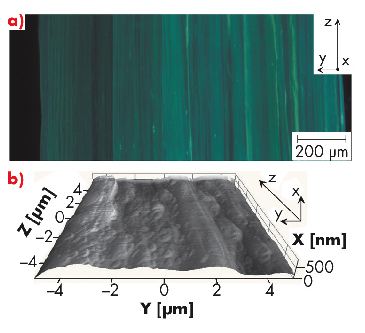- Home
- Users & Science
- Scientific Documentation
- ESRF Highlights
- ESRF Highlights 2010
- Soft condensed matter
- Aligned polyfluorene blends
Aligned polyfluorene blends
Phase behaviour and structure are essential factors in defining the physics and material properties of luminescent polymers such as polyfluorenes where attention is increasingly being devoted to larger scale structures incorporating intermolecular assemblies and the resulting microstructures. Bottom-up methods such as block copolymer synthesis have conventionally been used to study structures beyond the molecular level. While phase separation in such systems is constrained by the chemical bonds, blending two or more polymers into a single material expands the available parameter space and allows material properties to be tailored. Polymer blends can result in materials that have complete miscibility or are macrophase separated.
Macroscopic alignment of polyfluorene blends controls the macroscopic anisotropy within the blend and is reflected in the anisotropic optical characteristics. An interesting example is provided by King et al. [1] who demonstrated how an oriented blend of polyfluorene PF2/6 and polyethylene can be used as a tool to track the orientation of singlet and triplet transition dipole moments.
Heeger et al. [2] combined blending with alignment and studied the structural formation of another luminescent polymer poly(phenylene vinylene) incorporated in polyethylene. These authors raised the fraction of the luminescent polymer up to 30 wt% and aligned the samples, and studied them using X-ray diffraction. They found that the 30 wt% blend forms a uniform mixture of crystallites in non-aligned samples but a uniform mixture of chains in aligned samples. This structure was denoted as an interstitial microfibre. It is not known whether these kinds of microfibre phenomena play a role in polyfluorene blends.
We carried out fibre X-ray diffraction (XRD) and grazing-incidence X-ray diffraction (GIXRD) of aligned PF2/6 on beamline BM28 (XMaS) and reported the microstructure of an aligned blend. Our experiment aimed to provide a structural counterpart to the optical work of King et al. [1] who used a low polyfluorene fraction (< 0.7 wt%). Also, we aimed to provide the materials counterpart to the work of Heeger et al. [2] who used a different polymer and a high guest fraction. To cover the concentration regimes of both studies, the polyfluorene fraction was varied between 0.25 wt% and 15 wt%.
 |
|
Fig. 66: An aligned polyfluorene blend: a) Optical fluorescence micrograph, photoluminescence of polyfluorene appears as bluish lines; b) AFM topography, aligned along the z axis. |
Figure 66 shows an optical fluorescence image and AFM topography of the aligned material. Figure 67 shows typical XRD patterns of the corresponding film giving information of aligned polyfluorene crystallites (reflections at lower q) within aligned polyethylene crystallites (reflections at higher q). The information of the degree of their mutual alignment (mosaic) is also obtained by considering the integrated intensities of the different diffraction peaks.
 |
|
Fig. 67: XRD patterns of the aligned film measured with incoming beam a) parallel and b) perpendicular to the alignment direction, showing main reflections of both polymers. c) Integrated intensities of the main polyfluorene reflections. Φ is the angle between incident beam and y or z axes. |
We distinguished two cases: if the polyfluorene fraction is high (7-15 wt%) the blend was found to be a macroscopically uniform mixture of aligned polyethylene and polyfluorene crystallites (with a coherence length ~30 nm); if the polyfluorene fraction was low (0.25 wt%), the blend behaves similarly but the coherence length was significantly decreased (~8 nm). The photoluminescence data indicate chains are located in the vicinity of each other. Therefore, the reduction in coherence length is understood to involve a decrease in crystallite size. Unlike the case of poly(phenylene vinylene) [2], the crystallites are present in a very well aligned sample. This difference between the poly(phenylene vinylene) type polymer and polyfluorene can be explained in terms of compatibility, entanglement, and backbone stiffness. This kind of work provides an insight into the crystallite segregation in aligned polyfluorene blends. Similar blending and alignment procedures have been used for a diverse set of luminescent polymers but they have not, however, been studied by XRD.
This work required a high brilliance beam and advanced instrumentation that allowed us to work with small and thin films and very small polymer fractions. The importance of good control of the background scattering was also critical.
Principal publication and authors
M. Knaapila (a), H.L. Vaughan (b), T.P.A. Hase (c), R.C. Evans (d), R. Stepanyan (e), M. Torkkeli (f), H.D. Burrows (d), U. Scherf (g) and A.P. Monkman (b), Macromolecules 43, 299-305 (2010).
(a) Institute for Energy Technology (Norway)
(b) Durham University (UK)
(c) Warwick University (UK)
(d) University of Coimbra (Portugal)
(e) DSM Research (The Netherlands)
(f) University of Helsinki (Finland)
(g) University of Wuppertal (Germany)
References
[1] S.M. King, H.L. Vaughan and A.P. Monkman, Chem. Phys. Lett. 440, 268-272 (2007).
[2] C.Y. Yang, A.J. Heeger and Y. Cao, Polymer 41, 4113-4118 (2000).



